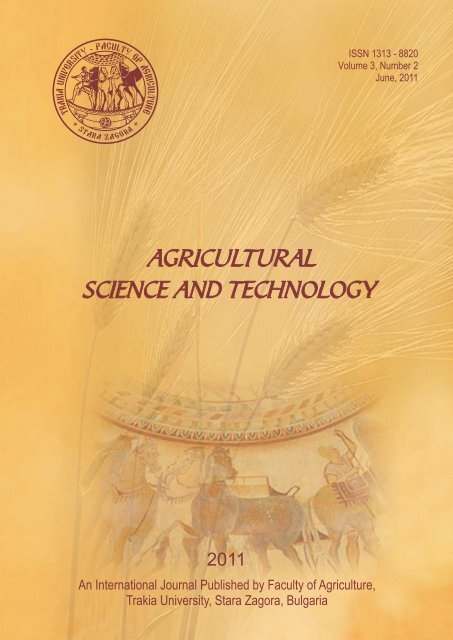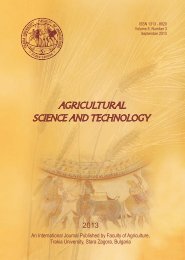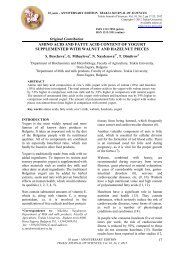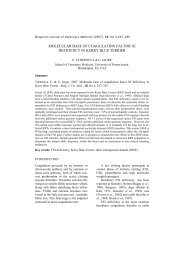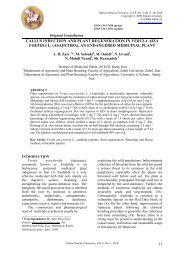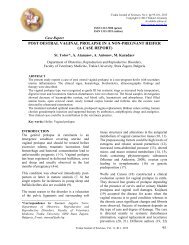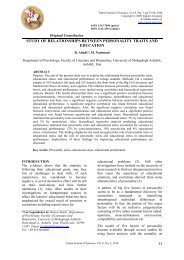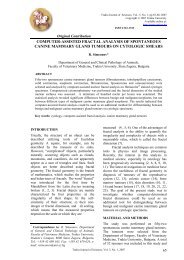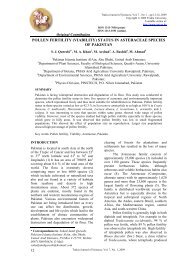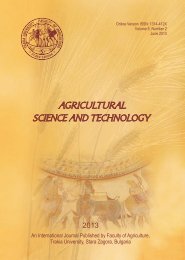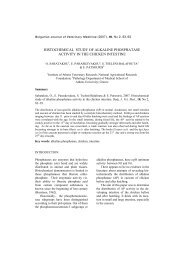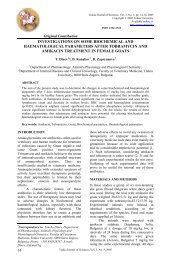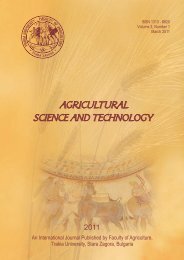Comparative study of different varieties of red clover in Bulgarian ...
Comparative study of different varieties of red clover in Bulgarian ...
Comparative study of different varieties of red clover in Bulgarian ...
Create successful ePaper yourself
Turn your PDF publications into a flip-book with our unique Google optimized e-Paper software.
AGRICULTURAL SCIENCE AND TECHNOLOGY, VOL. 3, No 2, pp 130 - 133, 2011<strong>Comparative</strong> <strong>study</strong> <strong>of</strong> <strong>different</strong> <strong>varieties</strong> <strong>of</strong> <strong>red</strong> <strong>clover</strong> <strong>in</strong> <strong>Bulgarian</strong> conditionsTs. Mihovski*, B. Chourcova, D. MitevResearch Institute <strong>of</strong> Mounta<strong>in</strong> Stockbreed<strong>in</strong>g and Agriculture, 5600 Troyan, BulgariaAbstract. Dur<strong>in</strong>g the 2007-2009 period <strong>in</strong> the experimental field <strong>of</strong> RIMSA – Troyan, a field trial was carried out with 10 <strong>varieties</strong> <strong>of</strong> <strong>red</strong> <strong>clover</strong>. Five <strong>varieties</strong> fromSwitzerland and four <strong>varieties</strong> from Japan were studied for Botanical composition, Morphological analysis, Yield <strong>of</strong> green mass and dry matter and Chemicalanalysis, compar<strong>in</strong>g them with a <strong>Bulgarian</strong> candidate variety from Troyan. There were no significant differences with regard to the yields <strong>of</strong> fresh and dry massfrom the <strong>different</strong> <strong>varieties</strong> <strong>of</strong> <strong>red</strong> <strong>clover</strong>. The diploid Japanese variety Sapporo was the highest-yield<strong>in</strong>g and it exceeded the candidate variety from Troyan byalmost 13% and 11% for the fresh and dry mass, respectively. It had also the best chemical composition, therefore it can be recommended to the practice <strong>in</strong> theforemounta<strong>in</strong>ous regions <strong>of</strong> Bulgaria. The highest presence <strong>of</strong> <strong>red</strong> <strong>clover</strong> was found <strong>in</strong> the second experimental year. The portion <strong>of</strong> stems was p<strong>red</strong>om<strong>in</strong>ant <strong>in</strong>the fresh mass <strong>of</strong> <strong>red</strong> <strong>clover</strong>, followed by that <strong>of</strong> leaves and flowers.Keywords: <strong>red</strong> <strong>clover</strong>, <strong>varieties</strong>, characteristicsIntroduction1. Botanical composition <strong>of</strong> green mass – determ<strong>in</strong>ed <strong>in</strong>percentage, through divid<strong>in</strong>g the mowed green mass <strong>in</strong>to <strong>red</strong> <strong>clover</strong>Red <strong>clover</strong> is one <strong>of</strong> the most used forage legumes <strong>in</strong>and all other species.agricultural practice (Sato et al., 2005). Its cultivation is particularly2. Morphological analysis (leaf<strong>in</strong>ess) – determ<strong>in</strong>ation <strong>of</strong> thepopular <strong>in</strong> the foremounta<strong>in</strong>ous regions where, due to more acidpercentage <strong>of</strong> leaves, stems and generative organs <strong>in</strong> the freshsoils, lucerne does not succeed. Under such conditions, Carr (2005)mass, tak<strong>in</strong>g an average sample per variant.affirmed that the two crops are equal <strong>in</strong> forage yield and quality. Very3. Yield <strong>of</strong> green mass and dry matter – determ<strong>in</strong>ed by the<strong>of</strong>ten it is also grown as a cover crop that decreases the temperaturegenerally accepted methods through mow<strong>in</strong>g at a height <strong>of</strong> 3-4 cm.<strong>in</strong> the ground layer and <strong>in</strong>creases the moisture retention (Thiessen,4. Chemical analysis – determ<strong>in</strong>ation <strong>of</strong> crude prote<strong>in</strong>, fiber and2001), as a companion species for weed <strong>red</strong>uction <strong>in</strong> ma<strong>in</strong> fieldash by generally accepted methods.crops (S<strong>in</strong>ger et al., 2000; Ross et al., 2001), for green manure or fordecrease <strong>of</strong> the nitrogen fertiliz<strong>in</strong>g (Sturz et al., 2003) etc. In RIMSA -Troyan there is a relatively considerable number <strong>of</strong> variety trials Results and discussioncarried out with <strong>red</strong> <strong>clover</strong>, but genetic plasma from distant Japanwas studied for the first time.The data presented <strong>in</strong> Table 1 show that there were noThe objective <strong>of</strong> this experiment was to <strong>study</strong> foreign <strong>varieties</strong> <strong>of</strong> significant differences with regard to the yields <strong>of</strong> fresh and dry mass<strong>red</strong> <strong>clover</strong> with a view to determ<strong>in</strong><strong>in</strong>g the most suitable ones for the from the <strong>different</strong> <strong>varieties</strong> <strong>of</strong> <strong>red</strong> <strong>clover</strong>. Nevertheless, we canconditions <strong>of</strong> foremounta<strong>in</strong>ous parts <strong>of</strong> Central Northern Bulgaria, as record the diploid Japanese variety Sapporo as the highest-yield<strong>in</strong>gwell as their use <strong>in</strong> the future breed<strong>in</strong>g work with <strong>red</strong> <strong>clover</strong>. one, exceed<strong>in</strong>g the candidate variety from Troyan by almost 13%and 11% for the fresh and dry mass, respectively. In the Japanesebreed<strong>in</strong>g, the <strong>varieties</strong> Hokuseki and Tiasetsu had also higher yieldsMaterial and methods– by 9,68 and 7,14 %, respectively, for the dry mass, whereas <strong>in</strong> theSwiss breed<strong>in</strong>g only variety Mont Calme was by about 8,5% higheryield<strong>in</strong>g.Compar<strong>in</strong>g the Japanese <strong>varieties</strong> (equal by orig<strong>in</strong>), weThe trial was laid out <strong>in</strong> the spr<strong>in</strong>g <strong>of</strong> 2007 <strong>in</strong> the experimentalfield <strong>of</strong> Research Institute <strong>of</strong> Mounta<strong>in</strong> Stockbreed<strong>in</strong>g and established that the tetraploid Tiasetsu was not higher-yield<strong>in</strong>g thanAgriculture (RIMSA) by the block method with 4 replications and a the diploid ones. J. S<strong>in</strong>gera et al. (2006), compar<strong>in</strong>g 15 <strong>varieties</strong>,size <strong>of</strong> trial plot <strong>of</strong> 5 sq. m. The follow<strong>in</strong>g <strong>varieties</strong> (variants) were reached to the same regularity.sown broadcast, by hand and at a sow<strong>in</strong>g rate <strong>of</strong> 15 kg/ha: KSThe data <strong>of</strong> botanical composition presented <strong>in</strong> Figure 1(candidate variety) from Troyan - (Standard), Pavo 2Х (Switzerland), confirms that <strong>red</strong> <strong>clover</strong> is a short-lived herbaceous forage species.Mont Calme (Switzerland), Mervla (Switzerland), Corws Its presence was the greatest dur<strong>in</strong>g the second experimental year,rd(Switzerland), Renova 2Х (Switzerland), Sapporo 2X (Japan), and <strong>in</strong> the 3 one its presence decreased for most tested <strong>varieties</strong>. InHokuseki 2X (Japan), Natsuyu 2X (Japan) and Tiasetsu 4X (Japan). relation to the first cuts, when usually the highest yields wereAfter sow<strong>in</strong>g, the area was rolled. Mow<strong>in</strong>g was conducted at the recorded, only <strong>varieties</strong> Corws, Renova and Natsuyu had higherstage <strong>of</strong> budd<strong>in</strong>g to early flower<strong>in</strong>g <strong>of</strong> <strong>red</strong> <strong>clover</strong> at a height <strong>of</strong> 3-4 cm. presence <strong>in</strong> the sward dur<strong>in</strong>g the third year. That could be due to theThe follow<strong>in</strong>g characteristics were recorded:higher percentage <strong>of</strong> hard seeds, hav<strong>in</strong>g <strong>in</strong> m<strong>in</strong>d their low* e-mail: mihovsky@mail.bg130
Table 2. Morphological analysisVariantsFl.st1 cutL.St.2008 2009Fl.nd2 cutL.St.Fl.st1 cutL.St.Fl.nd2 cutL.St.Fl.rd3 cutL.St.123456789107.710.38.211.19.713.014.815.014.819.821.524.116.319.425.822.221.318.320.419.870.865.575.569.464.564.863.966.764.860.530.833.331.833.325.031.838.134.631.634.430.829.222.728.631.322.728.630.826.328.138.537.545.538.143.845.533.334.642.137.56.37.15.88.36.19.17.96.15.69.131.335.729.033.326.836.432.933.338.927.362.557.165.258.367.154.559.260.655.663.615.415.48.313.814.323.513.818.216.711.130.830.833.343.128.623.534.527.327.833.353.853.858.343.157.152.951.754.555.655.612.54.21.85.92.74.33.87.12.85.654.279.286.070.667.674.576.978.690.369.433.316.712.323.529.721.319.214.36.925.0Table 3. Chemical analysis, g/kg DMVariantsCrude prote<strong>in</strong>Crude fiberAsher1. KS from Troyan, Bulgaria2.Pavo 2Х, Switzerland3.Mont Calme 2Х, Switzerland4.Mervla, Switzerland5.Corws, Switzerland6.Renova, Switzerland7.Sapporo 2X, Japan8.Hokuseki 2X, Japan9.Natsuyu 2X - Japan10.Tiasetsu 4X - Japan151.7167.0166.8165.2166.3168.5170.6165.8167.7169.6238.9225.0226.2227.1238.2221.5210.0216.9217.4218.558.056.160.955.752.354.359.057.658.753.4Conclusion<strong>clover</strong> <strong>varieties</strong> <strong>in</strong> Central Stara plan<strong>in</strong>a conditions. Union <strong>of</strong>Scientis- Vratza, 312-315.There were no significant differences with regard to the yields <strong>of</strong> Carr PM, Poland WW and, Tisor LJ, 2005. Forage Legumefresh and dry mass from the <strong>different</strong> <strong>varieties</strong> <strong>of</strong> <strong>red</strong> <strong>clover</strong>. The Regeneration from the Soil Seed Bank <strong>in</strong> Western North Dakota .diploid Japanese variety Sapporo was the highest-yield<strong>in</strong>g and it Agronomy Journal, 97, 505-513.exceeded the candidate variety from Troyan by almost 13% and 11% Goranova G, Churkova B and Mihovski Ts, 2003. Study <strong>of</strong>for fresh and dry mass, respectively. It had also the best chemical Introduced Red Clover (Trifolium pratense L.) Di- and Tetraploidcomposition, therefore it can be recommended to the practice <strong>in</strong> the Varieties Grown <strong>in</strong> Central North Bulgaria, <strong>Bulgarian</strong> Journal <strong>of</strong>foremounta<strong>in</strong>ous regions <strong>of</strong> the country. The highest presence <strong>of</strong> <strong>red</strong> Agriculture Science, 9, 2, 167-171.<strong>clover</strong> was found <strong>in</strong> the second experimental year. The portion <strong>of</strong> Goranova G and Mihovski Ts, 2005. Study <strong>of</strong> Reproductivestems was p<strong>red</strong>om<strong>in</strong>ant <strong>in</strong> the fresh mass <strong>of</strong> <strong>red</strong> <strong>clover</strong>, followed by Potential <strong>of</strong> Diploid and Teraploid Red Clover (Trifolium pretense L.)that <strong>of</strong> leaves and flowers.Cultivars under Conditions <strong>of</strong> the Central Balkan Mounta<strong>in</strong>s.<strong>Bulgarian</strong> Journal <strong>of</strong> Agriculture Science, 11, 141-145.Mihovski Ts, Goranova G, Ghesquiere A and Malengier M, 2005.ReferencesPrelim<strong>in</strong>ary results from the tests on fourteen <strong>red</strong> <strong>clover</strong> <strong>varieties</strong>under the feromounta<strong>in</strong> condition <strong>of</strong> Bulgaria. <strong>Bulgarian</strong> Journal <strong>of</strong>Agricultural Science, 11, 565-570.Goranova G and Mihovski Ts, 2000. Forage productivity potential Ross SM, K<strong>in</strong>g JR, César Izaurralde R and O'Donovan JT, 2001.and quality <strong>in</strong> <strong>red</strong> <strong>clover</strong> <strong>varieties</strong> and specimens. Journal <strong>of</strong> Weed Suppression by Seven Clover Species , Agronomy Journal,Mounta<strong>in</strong> Agriculture on the Balkans, 3, 6, 677-684. 93, 820-827.Goranova G and Mihovski Ts, 2005. Phenotype evaluation <strong>of</strong> Sato S, Isobe S, Asamizu E, Ohmido N, Kataoka R, Nakamura Y,variability <strong>of</strong> bioproductive and quality parameters <strong>of</strong> <strong>red</strong> <strong>clover</strong> Kaneko T, Sakurai N, Okumura K, Klimenko I, Sasamoto Sh,(Trifolium pratense L orig<strong>in</strong>ated from Europe and Asia. Ecology and Wada T, Watanabe A, Kohara M, Fujishiro T and Tabata S, 2005.Future, 2-3, 88-92.Comprehensive Structural Analysis <strong>of</strong> the Genome <strong>of</strong> Red CloverMihovsky Ts and Jantcheva N, 1998. <strong>Comparative</strong> <strong>study</strong> <strong>of</strong> <strong>red</strong> (Trifolium pratense L.). DNA Research, 12, 301–364.<strong>clover</strong> <strong>in</strong> Central North Bulgaria conditions. Journal <strong>of</strong> Mounta<strong>in</strong> Sturz AV, Arsenault W and Christie BR, 2003. Red Clover–PotatoAgriculture on the Balkans, 1, 3-4, 299-302.Cultivar Comb<strong>in</strong>ations for Improved Potato Yield. AgronomyMihovski Ts and Kozuharov J, 2001. <strong>Comparative</strong> <strong>study</strong> <strong>of</strong> <strong>red</strong> Journal, 95, 1089-1092.132
S<strong>in</strong>ger JW, Casler MD and Kohler KA, 2006. Effect on Frost- Agronomy Journal, 92, 754-760.Seeded Red Clover Cultivar Establishment and Yield. Agronomy Thiessen MJR, Hoeppner JW and Entz MH, 2001. Legume CoverJournal, 98, 265-269.Crops with W<strong>in</strong>ter Cereals <strong>in</strong> Southern Manitoba - Establishment,S<strong>in</strong>ger JW, Cox WJ, Hahn RR and Shields EJ, 2000. Cropp<strong>in</strong>g Productivity and Microclimate Effects. Agronomy Journal, 93, 1086-System Effects on Weed Emergence and Densities <strong>in</strong> Corn. 1096.133
AGRICULTURAL SCIENCE AND TECHNOLOGY, VOL. 3, No 2, 2011CONTENTS 1 / 2Genetics and Breed<strong>in</strong>gEffect <strong>of</strong> the age at first calv<strong>in</strong>g on test day production traits <strong>in</strong> black-and-white cowsZh. GergovskaEgg production potential <strong>of</strong> Manchurian Golden quail breedersA. GenchevVariability and stability <strong>of</strong> yield and quality <strong>of</strong> gra<strong>in</strong> <strong>of</strong> several bread wheat cultivarsN. Tsenov, I. Stoeva, T. Gubatov, V. PeevaProductive and quality characteristics <strong>of</strong> brown cottonA. Stoilova, I. Saldzhiev , Zh. TerzievSuperovulation and embryo transfer <strong>in</strong> goats by us<strong>in</strong>g PMSG or FSHA. Pampukidou, T. Alifakiotis, M. Avdi, R. Ivanova6773818894Nutrition and PhysiologyEffect <strong>of</strong> dietary am<strong>in</strong>o acid concentration on nitrogen balance <strong>in</strong> PIC hybrid pigsA. Ilchev, G. Ganchev<strong>Comparative</strong> studies on some parameters <strong>of</strong> <strong>in</strong>nate resistance and metabolic pr<strong>of</strong>ile <strong>of</strong> sheep and their <strong>of</strong>fspr<strong>in</strong>gdepend<strong>in</strong>g on the rationB. Bivolarski, Е. Vachkova, S. Laleva, P. Slavova, I. IvanovBehaviour <strong>of</strong> cows <strong>in</strong> milk<strong>in</strong>g parlourI. Varlyakov, V. Radev, Т. Slavov, N. Grigorova98103107Production SystemsFeed<strong>in</strong>g value <strong>of</strong> spr<strong>in</strong>g vetch (Vicia sativa L.) <strong>in</strong>fluenced by preparations with <strong>different</strong> biological effectY. Naydenova, N. Georgieva, I. NikolovaImpact <strong>of</strong> mixtures between retardants and comb<strong>in</strong>ed herbicides on the sow<strong>in</strong>g properties <strong>of</strong> the durum wheatG. DelchevPr<strong>of</strong>ile <strong>of</strong> lavender oil from second harvestG. Zhekova, N. NedkovEssential oil content and composition <strong>of</strong> Thyme “German w<strong>in</strong>ter”G. Zhekova, A. Dzhurmanski, M. NikolovaEffect <strong>of</strong> some agronomy factors on the cook<strong>in</strong>g properties <strong>of</strong> lentil seeds (Lens cul<strong>in</strong>aris Medic L.)G. Milev<strong>Comparative</strong> <strong>study</strong> <strong>of</strong> <strong>different</strong> <strong>varieties</strong> <strong>of</strong> <strong>red</strong> <strong>clover</strong> <strong>in</strong> <strong>Bulgarian</strong> conditionsTs. Mihovski, B. Chourcova, D. MitevStudy on the level <strong>of</strong> generated vacuum <strong>in</strong> the teat cup milk<strong>in</strong>g chamber as a factor for assess<strong>in</strong>g l<strong>in</strong>er suitabilityV. Vlashev, G. D<strong>in</strong>eva112117121123126130134
CONTENTS2 / 2Agriculture and EnvironmentContent <strong>of</strong> heavy metals and metalloids <strong>in</strong> bees and bee products from areas with <strong>different</strong> degree <strong>of</strong>anthropogenic impactI. Zhelyazkova, S. Atanasova, V. Barakova, G. MihaylovaSpecies composition <strong>of</strong> weeds <strong>in</strong> wheat and barleyM. Georgiev, D. Pavlov, G. Beev, M. Gerdzikova, R. BazitovVariability <strong>of</strong> some biologically active compounds <strong>of</strong> Tribulus terrestris L.M. Nikolova, A. Ivanova, I. Lazarova, D. Peev, N. ValyovskaOrganic matter status <strong>in</strong> reclaimed Technosols <strong>of</strong> BulgariaV. Tsolova, M. Banov136143150155Product Quality and SafetyUse <strong>of</strong> near<strong>in</strong>fra<strong>red</strong> spectroscopy technology with a remote reflectance fibre-optic probe for p<strong>red</strong>ict<strong>in</strong>g <strong>of</strong> traceelements contents <strong>in</strong> tobaccoL. Dospatliev, S. AtanassovaOccurrence and distribution <strong>of</strong> Fusarium species <strong>in</strong> wheat gra<strong>in</strong>G. Beev, S. Denev, D. PavlovInfluence the extraction acidity level on the amount and chemical composition <strong>of</strong> essential oil from Rosadamascena Mill.A. DobrevaDistribution <strong>of</strong> moisture <strong>in</strong> the soil pr<strong>of</strong>ile <strong>in</strong> terms <strong>of</strong> two soil typesA. Stoyanova, M. TodorovaSlaughter<strong>in</strong>g analysis and chemical composition <strong>of</strong> rabbit meatA.Kuzelov, E. Atanasova, T. AngelkovaGra<strong>in</strong> sample quality assessment us<strong>in</strong>g Intechn and Unscrambler platformsM. Mladenov, Ts. Draganova, R. Tsenkova160165169172176179
Instruction for authorsPreparation <strong>of</strong> papersPapers shall be submitted at the editorial<strong>of</strong>fice typed on standard typ<strong>in</strong>g pages (A4,30 l<strong>in</strong>es per page, 62 characters per l<strong>in</strong>e).The editors recommend up to 15 pages forfull research paper ( <strong>in</strong>clud<strong>in</strong>g abstractreferences, tables, figures and otherappendices)The manuscript should be structu<strong>red</strong> asfollows: Title, Names <strong>of</strong> authors andaffiliation address, Abstract, List <strong>of</strong>keywords, Introduction, Material andm e t h o d s , R e s u l t s , D i s c u s s i o n ,Conclusion, Acknowledgements (if any),References, Tables, Figures.The title needs to be as concise and<strong>in</strong>formative about the nature <strong>of</strong> research. Itshould be written with small letter /bold, 14/without any abbreviations.Names and affiliation <strong>of</strong> authorsThe names <strong>of</strong> the authors should bepresented from the <strong>in</strong>itials <strong>of</strong> first namesfollowed by the family names. Thecomplete address and name <strong>of</strong> the<strong>in</strong>stitution should be stated next. Theaffiliation <strong>of</strong> authors are designated by<strong>different</strong> signs. For the author who is go<strong>in</strong>gto be correspond<strong>in</strong>g by the editorial boardand readers, an E-mail address andtelephone number should be presented asfootnote on the first page. Correspond<strong>in</strong>gauthor is <strong>in</strong>dicated with *.Abstract should be not more than 350words. It should be clearly stated what newf<strong>in</strong>d<strong>in</strong>gs have been made <strong>in</strong> the course <strong>of</strong>research. Abbreviations and references toauthors are <strong>in</strong>admissible <strong>in</strong> the summary. Itshould be understandable without hav<strong>in</strong>gread the paper and should be <strong>in</strong> oneparagraph.Keywords: Up to maximum <strong>of</strong> 5 keywordsshould be selected not repeat<strong>in</strong>g the titlebut giv<strong>in</strong>g the essence <strong>of</strong> <strong>study</strong>.The <strong>in</strong>troduction must answer thefollow<strong>in</strong>g questions: What is known andwhat is new on the studied issue? Whatnecessitated the research problem,described <strong>in</strong> the paper? What is yourhypothesis and goal ?Material and methods: The objects <strong>of</strong>research, organization <strong>of</strong> experiments,chemical analyses, statistical and othermethods and conditions applied for theexperiments should be described <strong>in</strong> detail.A criterion <strong>of</strong> sufficient <strong>in</strong>formation is to bepossible for others to repeat theexperiment <strong>in</strong> order to verify results.Results are presented <strong>in</strong> understandabletables and figures, accompanied by thestatistical parameters needed for theevaluation. Data from tables and figuresshould not be repeated <strong>in</strong> the text.Tables should be as simple and as few aspossible. Each table should have its ownexplanatory title and to be typed on aseparate page. They should be outside thema<strong>in</strong> body <strong>of</strong> the text and an <strong>in</strong>dicationshould be given where it should be<strong>in</strong>serted.Figures should be sharp with goodcontrast and rendition. Graphic materialsshould be prefer<strong>red</strong>. Photographs to beappropriate for pr<strong>in</strong>t<strong>in</strong>g. Illustrations aresupplied <strong>in</strong> colour as an exception afterspecial agreement with the editorial boardand possible payment <strong>of</strong> extra costs. Thefigures are to be each <strong>in</strong> a s<strong>in</strong>gle file andtheir location should be given with<strong>in</strong> thetext.Discussion: The objective <strong>of</strong> this sectionis to <strong>in</strong>dicate the scientific significance <strong>of</strong>the <strong>study</strong>. By compar<strong>in</strong>g the results andconclusions <strong>of</strong> other scientists thecontribution <strong>of</strong> the <strong>study</strong> for expand<strong>in</strong>g ormodify<strong>in</strong>g exist<strong>in</strong>g knowledge is po<strong>in</strong>tedout clearly and conv<strong>in</strong>c<strong>in</strong>gly to the reader.Conclusion: The most important consequencesfor the science and practiceresult<strong>in</strong>g from the conducted researchshould be summarized <strong>in</strong> a few sentences.The conclusions shouldn't be numbe<strong>red</strong>and no new paragraphs be used.Contributions are the core <strong>of</strong> conclusions.References:In the text, references should be cited asfollows: s<strong>in</strong>gle author: Sandberg (2002);two authors: Andersson and Georges(2004); more than two authors: Anderssonet al.(2003). When several references arecited simultaneously, they should beranked by chronological order e.g.:(Sandberg, 2002; Andersson et al., 2003;Andersson and Georges, 2004).References are arranged alphabetically bythe name <strong>of</strong> the first author. If an author iscited more than once, first his <strong>in</strong>dividualpublications are given ranked by year, thencome publications with one co-author, twoco-authors, etc. The names <strong>of</strong> authors,article and journal titles <strong>in</strong> the Cyrillic oralphabet <strong>different</strong> from Lat<strong>in</strong>, should betransliterated <strong>in</strong>to Lat<strong>in</strong> and article titlesshould be translated <strong>in</strong>to English.The orig<strong>in</strong>al language <strong>of</strong> articles and bookstranslated <strong>in</strong>to English is <strong>in</strong>dicated <strong>in</strong>parenthesis after the bibliographicreference (<strong>Bulgarian</strong> = Bg, Russian = Ru,Serbian = Sr, if <strong>in</strong> the Cyrillic, Mongolian =Мо, Greek = Gr, Georgian = Geor.,Japanese = Jа, Ch<strong>in</strong>ese = Ch, Arabic = Аr,etc.)The follow<strong>in</strong>g order <strong>in</strong> the reference list isrecommended:Journal articles: Author(s) surname and<strong>in</strong>itials, year. Title. Full title <strong>of</strong> the journal,volume, pages. Example:Simm G, Lewis RM, Grundy B andD<strong>in</strong>gwall WS, 2002. Responses toselection for lean growth <strong>in</strong> sheep. AnimalScience, 74, 39-50Books: Author(s) surname and <strong>in</strong>itials,year. Title. Edition, name <strong>of</strong> publisher,place <strong>of</strong> publication. Example:Oldenbroek JK, 1999. Genebanks andthe conservation <strong>of</strong> farm animal geneticresources, Second edition. DLO Institutefor Animal Science and Health,Netherlands.Book chapter or conference proceed<strong>in</strong>gs:Author(s) surname and <strong>in</strong>itials, year. Title.In: Title <strong>of</strong> the book or <strong>of</strong> the proceed<strong>in</strong>gsfollowed by the editor(s), volume, pages.Name <strong>of</strong> publisher, place <strong>of</strong> publication.Example:Mauff G, Pulverer G, Operkuch W,Hummel K and Hidden C, 1995. C3-variants and diverse phenotypes <strong>of</strong>unconverted and converted C3. In:Provides <strong>of</strong> the Biological Fluids (ed. H.Peters), vol. 22, 143-165, PergamonPress. Oxford, UK.Todorov N and Mitev J, 1995. Effect <strong>of</strong>level <strong>of</strong> feed<strong>in</strong>g dur<strong>in</strong>g dry period, and bodycondition score on reproductivet hperformance <strong>in</strong> dairy cows, IXInternational Conference on ProductionDiseases <strong>in</strong> Farm Animals, Sept.11 – 14,Berl<strong>in</strong>, Germany, p. 302 (Abstr.).Thesis:Penkov D, 2008. Estimation <strong>of</strong> metabolicenergy and true digestibility <strong>of</strong> am<strong>in</strong>o acids<strong>of</strong> some feeds <strong>in</strong> experiments with muscusduck (Car<strong>in</strong>a moshata, L). Thesis for DSc.Agrarian University, Plovdiv, 314 pp.The Editorial Board <strong>of</strong> the Journal is notresponsible for <strong>in</strong>correct quotes <strong>of</strong>reference sources and the relevantviolations <strong>of</strong> copyrights.
Volume 3, Number 2June 2011


